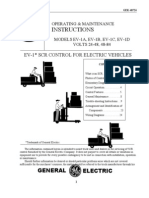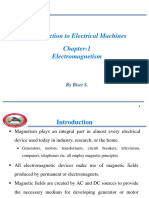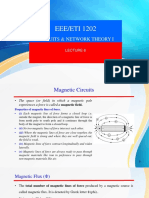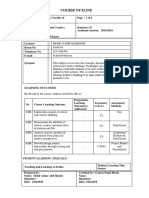Magnet: Prepared by Mr. Lim Cheng Siong Faculty of Electrical Engineering Universiti Teknologi Malaysia
Magnet: Prepared by Mr. Lim Cheng Siong Faculty of Electrical Engineering Universiti Teknologi Malaysia
Uploaded by
Kenneth ChawCopyright:
Available Formats
Magnet: Prepared by Mr. Lim Cheng Siong Faculty of Electrical Engineering Universiti Teknologi Malaysia
Magnet: Prepared by Mr. Lim Cheng Siong Faculty of Electrical Engineering Universiti Teknologi Malaysia
Uploaded by
Kenneth ChawOriginal Description:
Original Title
Copyright
Available Formats
Share this document
Did you find this document useful?
Is this content inappropriate?
Copyright:
Available Formats
Magnet: Prepared by Mr. Lim Cheng Siong Faculty of Electrical Engineering Universiti Teknologi Malaysia
Magnet: Prepared by Mr. Lim Cheng Siong Faculty of Electrical Engineering Universiti Teknologi Malaysia
Uploaded by
Kenneth ChawCopyright:
Available Formats
1
Chapter 4
Magnet
Prepared by
Mr. Lim Cheng Siong
Faculty of Electrical Engineering
Universiti Teknologi Malaysia
2
Contents
Magnetic Field
Magnetic Relationships
Self and Mutual Inductances
Magnetic Circuit
3
Electromagnetism
Electricity and magnetism cannot be separated.
Wherever an electric current exists, a magnetic field also
exists.
Magnetism, created by an electric current, operates
many devices, such as transformers, motors, and
loudspeakers.
4
Magnetism and Magnets
What is magnetism?
Magnetism is a force field that acts on some
materials but not on other materials.
Physical devices that possess this force are
called magnets.
5
Magnets Material
Lodestone (an iron compound) is a natural magnet that
was discovered centuries ago
The magnet we used today are all manufactured.
They are made from various alloys containing elements
like copper, nickel, aluminium, iron, and cobalt.
These magnets are much, much stronger than natural
lodestone magnet
6
Magnetic Field
The force of magnetism is referred to as
a magnetic field.
This field extends out from the magnet in
all directions, as illustrated in the figure
(Magnetic field around a bar magnet)
Two poles dictated by direction of the
field
Opposite poles attract (aligned magnetic
field)
Same poles repel (opposing magnetic
field)
7
Magnetic Field
8
Field Detector
Can use a compass to map out
magnetic field
Field forms closed flux lines
around the magnet
Magnetic flux measured in
Webers (Wb)
Symbol
u
9
Magnetic Field Conductor
A magnetic field also forms
round a conductor along
which a current is flowing
Field can be described using
right hand screw rule
10
Right Hand Rule
Thumb indicates
direction of current
flow
Finger curl indicates
the direction of field
11
Magnetic Field: Coil
Placing a ferrous material inside the coil
increases the magnetic field
Acts to concentrate the field also notice
field lines are parallel inside ferrous
element
flux density has increased
12
Contents
Magnetic Field
Magnetic Relationships
Self and Mutual Inductances
Magnetic Circuit
13
Magnetic Flux
Magnetic flux lines possess the following properties:
They form closed loops.
Always starts from the north pole (N) and end in the south pole (S) and are
then continuous through the body of the magnet.
Never intersect each other
Lines of magnetic flux that are parallel and in the same direction, repel one
another.
The total number of lines of force in the magnetic field is
called the magnetic flux.
14
Flux Density
Magnetic flux density is defined as the magnetic flux per
unit area of a surface at right angles to the magnetic field.
15
Permeability
The measure of the degree to which lines of force of the
magnetizing field can penetrate the medium is called Permeability
(H/m)
Permeability of all non-magnetic materials including air
o
= 4
x 10
-7
(H/m)
Relative permeability:
16
B-H Curve
B(T)
H(A/m)
Magnetization curve (B-H characteristic)
Saturation
H B
r 0
=
17
Reluctance
Reluctance: resistance to flow of
magnetic flux
Associated with magnetic circuit flux
equivalent to current
Whats equivalent of voltage?
18
Fringing Effect
19
Magnetomotive Force
Magnetomotive force can be
produced when current flows in a
coil of one or more turns.
Driving force F needed to overcome
toroid reluctance
20
Magnetomotive Force
The MMF is generated by the coil
Strength related to number of turns and current,
measured in Ampere turns (At)
21
Field Intensity
The longer the magnetic path the greater the MMF
required to drive the flux
Magnetomotive force per unit length is known as the
magnetizing force H
Magnetizing force and flux density related by:
22
Summary
23
Electric & Magnetic Circuit
Term Symbol Term Symbol
Magnetic flux u Electric current I
Flux density B Current density J
Magnetic field
strength
H Electric field strength E
Magnetomotive force F Electromotive force E
Permeability Permittivity c
Reluctance Resistance R
Magnetic circuit Electric circuit
9
24
Contents
Magnetic Field
Magnetic Relationships
Self and Mutual Inductances
Magnetic Circuit
25
Induction
Faraday has made the great discovery of electromagnet induction,
namely a method of obtaining an electric current with the aid of
magnetic flux.
(a)
(b)
When a conductor cuts or is cut by a
magnetic flux, an e.m.f. is generated
in the conductor.
S
A B
G
G
S N
C
26
Inductance
A coil wound on a magnetic core, such as shown in the Fig., is frequently
used in electric circuits.
This coil may be represented by an ideal circuit element, called inductance,
which is defined as the flux linkage of the coil per ampere of its current.
lc
i
N
L
27
Inductance
The e.m.f induced in electric circuit
Equating expressions of e.m.f induced in magnetic circuit
and electric circuit:
L is the self-inductance in Henry, or simply the inductance.
For and so
dt
di
L e =
dt
d
N
dt
di
L
|
=
S
F
= u
A
l
S
r 0
=
L= ?
current of change
linkages flux of change
di
d
N L = =
|
28
Inductance
If a conductor cuts or is cut by a flux of
d webers in dt seconds, e.m.f generated
in conductor
dt
d
e
|
=
volt
t
u
dt
d
N e
|
=
S N
C
X
Motion
The average e.m.f induced in one turn is
e.m.f induced in a coil:
29
Example 7
For the magnetic circuit, N = 400 turns. Mean core length
= 50 cm. Air gap length =
1.0 mm. Cross-sectional area (A
c
= A
g
) = 15 cm
2
. Relative permeability of core =
3000.
i = 1.0 A.
Find
(a) Flux density in the air gap. (0.43 T)
(b) Inductance of the coil. (258.52 x 10
-3
H)
l
c
i
N
l
g
+
F
-
u
c
9
g
9
30
Mutual Inductance
S
A B
G
|
A
|
B
S
N
N I
N
I
N
L
A
A A
A A
A
A A
A
2 2
=
u
=
u
=
S
N
I
N
L
B
B
B B
B
2
=
u
=
31
Mutual Inductance
B
B B
A
A A
N I N I
S
u
=
u
=
S
N N
M
N I
N N
I
N
M
B A
A A
A B A
A
A B
=
u
=
u
=
2
2
2 2
M
S
N N
L L
B A
B A
= =
B A
L L M = Mutual Inductance:
32
Contents
Magnetic Field
Magnetic Relationships
Self and Mutual Inductances
Magnetic Circuit
33
Magnetic Circuit
lc
i
N
+
F
-
u
9
E
R
i
Equivalent circuit
Analogy between magnetic circuit and
electric circuit
34
Example 1.
A toroid of 200 turns is wound uniformly over a wooden ring having a
mean circumference of 600 mm and a uniform cross-sectional area of
500 mm
2.
If the current through the toroid is 4 A, calculate
a. The magnetic field strength
b. The flux density
c. The total flux.
[
35
Example 2.
A toroid of 200 turns is wound uniformly over a core (with relative
permeability of 500) having a mean circumference of 600 mm and a
uniform cross-sectional area of 500 mm
2.
If the current through the toroid
is 4 A, calculate
a. The magnetic field strength
b. The flux density
c. The total flux.
36
Magnetic Circuit with Air Gap
l
c
i
N
l
g
+
F
-
u
c
9
g
9
0
;
;
g
c
c g
c c g
C g
c g
c g
l
l
A A
Ni
Flux density
B B
A A
9 = 9 =
u =
9 +9
u u
= =
37
Example 3
l
c
i
N
l
g
Calculate the magnetomotive force required to
produce a flux of 0.015 Wb across air gap 2.5 mm long,
having an effective area of 200 cm
2
38
Series Magnetic Circuit
; ;
a b c
a b c
a a b b c c
a b c
l l l
A A A
Ni
9 = 9 = 9 =
u =
9 +9 +9
i
N
iron steel
cobalt
+
F
-
u
b
9
a
9
c
9
39
Example 4
A magnetic circuit comprises three parts in series ,
each of uniform cross-sectional area (A). They are:
(a) a length of 80 mm and A= 50 mm
2
(b) a length of 60 mm and A = 90 mm
2
(c) an air gap of length 0.5 mm and A = 150 mm
2
A coil of 4000 turns is wound on part (b) and the flux
density in the airgap is 0.3 T. Assuming that all the flux
passes through the given circuit, and the relative
permeability is 1300, estimate the coil current to
produce such a flux density.
40
Example 5
41
42
43
0.02 50399 1008
1008
2.02
500
F At
F
I A
N
| = 9= =
= = =
You might also like
- EV1 SCR Motor ControllerDocument32 pagesEV1 SCR Motor ControllerJShearer95% (20)
- MagneticDocument14 pagesMagneticNurulazmi Bin Abd RahmanNo ratings yet
- EEB326 Electrical Machines I - Lectures 1-3-2013Document110 pagesEEB326 Electrical Machines I - Lectures 1-3-2013Derrick Maatla Moadi100% (1)
- Chapter No. 01: Magnetic CircuitsDocument53 pagesChapter No. 01: Magnetic CircuitsUmar Sheikh100% (1)
- 4 - Simple Magnetic Circuits - 2019Document22 pages4 - Simple Magnetic Circuits - 2019ZAINAB MOFFATNo ratings yet
- Electrical MachinesDocument13 pagesElectrical MachinesKim Balcueba100% (1)
- Notes PPT UNIT-2Document21 pagesNotes PPT UNIT-2ajha88475No ratings yet
- Magnetic CircuitsDocument38 pagesMagnetic CircuitsHanan Kemal100% (1)
- Lect 11 23EEE101 Magnetic CircuitsDocument60 pagesLect 11 23EEE101 Magnetic CircuitsNjan KL16么PorottaNo ratings yet
- EE352 Chapter#2 Electromagnetism and Magnetic CurcuitsDocument55 pagesEE352 Chapter#2 Electromagnetism and Magnetic CurcuitsCan ARABACI100% (1)
- Lecture 1-Magnetic CircuitsDocument40 pagesLecture 1-Magnetic CircuitsmtlozaneNo ratings yet
- Magnetic CircuitsDocument52 pagesMagnetic Circuitsgopi_905100% (2)
- DC MachinesDocument34 pagesDC MachinesCristele Mae GarciaNo ratings yet
- Chapter One Electromagnetic Principle-1Document68 pagesChapter One Electromagnetic Principle-1DANIEL WELDAYNo ratings yet
- Eee3352 L5Document42 pagesEee3352 L5Desmond CheweNo ratings yet
- 1.1 Review of Magnetic Circuits and Its PropertiesDocument65 pages1.1 Review of Magnetic Circuits and Its PropertiesChimi WangmoNo ratings yet
- Electric Machine: Magnetic CircuitDocument39 pagesElectric Machine: Magnetic CircuitYasir ButtNo ratings yet
- Chapter # 1Document50 pagesChapter # 1derresesolomon36No ratings yet
- Basic Electromagnet1Document73 pagesBasic Electromagnet1FadzlanFathullahNo ratings yet
- Ac/Dc Machinery Chapter Compilation: John Alfred A. Ceniza BSME-5Document42 pagesAc/Dc Machinery Chapter Compilation: John Alfred A. Ceniza BSME-5John A. CenizaNo ratings yet
- Machine Work Sheet With AnswerDocument20 pagesMachine Work Sheet With AnswerTeklu AnbeseNo ratings yet
- Unit-1 Magnetic CircuitDocument52 pagesUnit-1 Magnetic Circuitollata kalano100% (1)
- QB105341Document11 pagesQB105341KURAKULA VIMAL KUMARNo ratings yet
- Introduction To Magnetic CircuitsDocument23 pagesIntroduction To Magnetic Circuitssharad kumarNo ratings yet
- Ch1 Magnetic CircuitsDocument65 pagesCh1 Magnetic Circuitsstdesai1005No ratings yet
- 2016 Exercise On Capter One (Magnetics)Document4 pages2016 Exercise On Capter One (Magnetics)Yonas BelaynehNo ratings yet
- Chapter 1 Introduction To Electrical MachineryDocument33 pagesChapter 1 Introduction To Electrical MachineryShikoyeniNo ratings yet
- Unit 1 Magnetism and ElectromagnetismDocument53 pagesUnit 1 Magnetism and ElectromagnetismOdellien Saja100% (1)
- Chapter 1Document37 pagesChapter 1playerNo ratings yet
- ch1 Magnetic CircuitsDocument66 pagesch1 Magnetic CircuitsRaymundo III ApaleNo ratings yet
- Magnetic Materials and Circuits: Describe, Explain and Calculate Fundamental of Electricity, Magnetism and CircuitsDocument56 pagesMagnetic Materials and Circuits: Describe, Explain and Calculate Fundamental of Electricity, Magnetism and Circuitscarlos beltranNo ratings yet
- Magnetic Circuits: - Series Magnetic Circuit - Parallel Magnetic Circuit - Series-Parallel Magnetic CircuitsDocument37 pagesMagnetic Circuits: - Series Magnetic Circuit - Parallel Magnetic Circuit - Series-Parallel Magnetic Circuitsprashanth100% (1)
- Mimay, Noeh M. Bsee - 2B Electromagnetics Tutorial Problem 62Document6 pagesMimay, Noeh M. Bsee - 2B Electromagnetics Tutorial Problem 62Glorilie PazNo ratings yet
- Magnetic CircuitsDocument40 pagesMagnetic Circuitssubashini parivelNo ratings yet
- Magnetic Field and Magnetic Flux Density v2Document24 pagesMagnetic Field and Magnetic Flux Density v2Pao CastillonNo ratings yet
- Unit 2 EEEDocument185 pagesUnit 2 EEEDevendra BansalNo ratings yet
- Magnetics ConstantsDocument22 pagesMagnetics ConstantsPaolo Steven PolintanNo ratings yet
- Introduction To Electrical Machine Week 1Document38 pagesIntroduction To Electrical Machine Week 1vitileeNo ratings yet
- Chapter 5 Magnetic Induction Final 1Document52 pagesChapter 5 Magnetic Induction Final 1Salve Marie DoratoNo ratings yet
- Lecture 6-Magnetic CircuitsDocument49 pagesLecture 6-Magnetic CircuitsMAENYA BRUCE OYONDINo ratings yet
- MagnetismDocument57 pagesMagnetismTammanurRaviNo ratings yet
- Chapter 1 MACHINESDocument30 pagesChapter 1 MACHINESalia khanNo ratings yet
- 1.1: Discuss The Effect On The Magnitude of The Force On A Current-Carrying Conductor of Variations inDocument20 pages1.1: Discuss The Effect On The Magnitude of The Force On A Current-Carrying Conductor of Variations inYousef YohannaNo ratings yet
- Chapter 5 (Magnetic Circuit)Document43 pagesChapter 5 (Magnetic Circuit)伟伦100% (1)
- DC Machines Module 2Document17 pagesDC Machines Module 2Joshua Roberto GrutaNo ratings yet
- Electrical Machine1Document8 pagesElectrical Machine1Raja TNo ratings yet
- Why Ac DC TransformersDocument21 pagesWhy Ac DC Transformersapi-252130436No ratings yet
- Chapter 5 Magnetic CircuitDocument44 pagesChapter 5 Magnetic CircuitAfie Fahry AdzmiNo ratings yet
- Chapter 30 PhysicsDocument29 pagesChapter 30 Physicseg40340% (1)
- Lesson 2 Biot Savart LawDocument44 pagesLesson 2 Biot Savart LawYousef SerriahNo ratings yet
- Magnetic CircuitDocument22 pagesMagnetic Circuitjclay06No ratings yet
- Magnetic Circuit PDFDocument41 pagesMagnetic Circuit PDFAli Al-dulaimyNo ratings yet
- Unit-4 Transformer (Magnetic Circuit) - 1-4Document4 pagesUnit-4 Transformer (Magnetic Circuit) - 1-4rajsandeep2410No ratings yet
- Unit 1 ElectromagntismDocument22 pagesUnit 1 ElectromagntismDaminiNo ratings yet
- ElectromagnetismDocument23 pagesElectromagnetismWommbitNo ratings yet
- Ee201 Notes1 HoleyDocument47 pagesEe201 Notes1 HoleyUmamaheswar ReddyNo ratings yet
- 06-Mydin DoneDocument12 pages06-Mydin DoneKenneth Chaw100% (1)
- Part 2Document1 pagePart 2Kenneth ChawNo ratings yet
- Orientation Test-01 - IndexDocument1 pageOrientation Test-01 - IndexKenneth ChawNo ratings yet
- Hello PDFDocument3 pagesHello PDFKenneth ChawNo ratings yet
- Cylinder DrawingDocument1 pageCylinder DrawingKenneth ChawNo ratings yet
- Create 3D Solid Primitives:: Switch To The 3D Modeling WorkspaceDocument4 pagesCreate 3D Solid Primitives:: Switch To The 3D Modeling WorkspaceKenneth ChawNo ratings yet
- Fuel of Give Out of Calorific Ofoxygen, ofDocument17 pagesFuel of Give Out of Calorific Ofoxygen, ofKenneth ChawNo ratings yet
- Examples BoilerDocument5 pagesExamples BoilerKenneth ChawNo ratings yet
- Identifying Customer Needs SweetwaterDocument26 pagesIdentifying Customer Needs SweetwaterKenneth ChawNo ratings yet
- Practical Paper Model PDFDocument2 pagesPractical Paper Model PDFKenneth ChawNo ratings yet
- Academy Award: Current Special CategoriesDocument1 pageAcademy Award: Current Special CategoriesKenneth ChawNo ratings yet
- Bearing SelectionDocument6 pagesBearing SelectionKenneth ChawNo ratings yet
- Jawapan Test 1Document2 pagesJawapan Test 1Kenneth ChawNo ratings yet
- Limit - Switch Test1 Sheet1Document1 pageLimit - Switch Test1 Sheet1Kenneth ChawNo ratings yet
- Uhas 2122 Course Outline - 2016Document4 pagesUhas 2122 Course Outline - 2016Kenneth ChawNo ratings yet
- Before The Experiment Start, The Apparatus and Materials Are Set Up As Figure 4.1 BelowDocument3 pagesBefore The Experiment Start, The Apparatus and Materials Are Set Up As Figure 4.1 BelowKenneth ChawNo ratings yet
- Roles and ResponsibilityDocument2 pagesRoles and ResponsibilityKenneth ChawNo ratings yet
- InsDocument1 pageInsKenneth ChawNo ratings yet
- Test 1Document1 pageTest 1Kenneth ChawNo ratings yet
- Thermoplastics: by Kenneth Chaw (A13KM0053)Document7 pagesThermoplastics: by Kenneth Chaw (A13KM0053)Kenneth ChawNo ratings yet
- Friction Lab Video Notes 1Document3 pagesFriction Lab Video Notes 1api-372548146No ratings yet
- Dovetail SlidesDocument30 pagesDovetail SlideskanagarajuNo ratings yet
- Parker Electronics Update 160316 PDFDocument71 pagesParker Electronics Update 160316 PDFMaria Lavinia IordacheNo ratings yet
- Model Question Paper Applied Electromagnetic TheoryDocument2 pagesModel Question Paper Applied Electromagnetic TheoryakhilarajNo ratings yet
- The Physics of Racing Part 1: Weight TransferDocument35 pagesThe Physics of Racing Part 1: Weight TransferOğuzhan SaçıNo ratings yet
- Due Date: Aug 8, 2016: Basic Components, Voltage & Current Laws, Nodal AnalysisDocument21 pagesDue Date: Aug 8, 2016: Basic Components, Voltage & Current Laws, Nodal Analysisgopika1991No ratings yet
- Design of Canals PDFDocument46 pagesDesign of Canals PDFphani100% (5)
- Please Do Now: in Full Sentences, Write (3) Things You Know About Gravity and (1) Thing You Would Like To LearnDocument31 pagesPlease Do Now: in Full Sentences, Write (3) Things You Know About Gravity and (1) Thing You Would Like To LearnAlizza tanglibenNo ratings yet
- Lesson 11 DC Transient AnalysisDocument81 pagesLesson 11 DC Transient AnalysisJoshua JapitanNo ratings yet
- EEE 1105 011 Comparison of The Effects of Phase To Ground FaultsDocument7 pagesEEE 1105 011 Comparison of The Effects of Phase To Ground FaultsFAKEIDS421No ratings yet
- Department of Electrical and Electronics Engineering Guru Nanak Institute of Technology - IbrahimpatnamDocument3 pagesDepartment of Electrical and Electronics Engineering Guru Nanak Institute of Technology - IbrahimpatnamsunilkumareceNo ratings yet
- Goodrive300 Inverter Operation Manual - V3.3Document303 pagesGoodrive300 Inverter Operation Manual - V3.3Chan PhingNo ratings yet
- List of Most Mastered and Least Mastered Learning Competencies in Science 8Document8 pagesList of Most Mastered and Least Mastered Learning Competencies in Science 8Jayvee Hubernadas CanaricioNo ratings yet
- CB Spec SvenskaDocument44 pagesCB Spec SvenskaTravis WoodNo ratings yet
- Altitude and Orbit ControlDocument17 pagesAltitude and Orbit Controlshruti soniNo ratings yet
- Data Sheet: PRO TOP1 240W 24V 10A EXDocument6 pagesData Sheet: PRO TOP1 240W 24V 10A EXThilak PonnusamyNo ratings yet
- Kami Export ForceandMotionWorksheets 1 Part 1Document2 pagesKami Export ForceandMotionWorksheets 1 Part 1Henry Mejia HurtadoNo ratings yet
- Problema LevasDocument5 pagesProblema LevasCarlos A. Iriarte Martinez100% (1)
- S.C Calculations: Short Circuit StudyDocument17 pagesS.C Calculations: Short Circuit StudyAhmedRaafatNo ratings yet
- QC-151 Motor Inspection TestDocument1 pageQC-151 Motor Inspection TestcisyabNo ratings yet
- Additional ProblemsDocument2 pagesAdditional ProblemsSubhasis MaityNo ratings yet
- Function Generator: Hendro DarmonoDocument9 pagesFunction Generator: Hendro DarmonouyabzzNo ratings yet
- Cavendish LabDocument4 pagesCavendish LabSuraj PatelNo ratings yet
- Full Wave RectifierDocument5 pagesFull Wave RectifierAmulya TengNo ratings yet
- Moving Coil GalvanometerDocument5 pagesMoving Coil GalvanometerAshok PradhanNo ratings yet
- A Gestalt Perspective On Working With Group Process by John Bernard HarrisDocument15 pagesA Gestalt Perspective On Working With Group Process by John Bernard HarrisMariana BorodeaNo ratings yet
- Forced Vibrations With Negligible Damping: I-IntroductionDocument9 pagesForced Vibrations With Negligible Damping: I-IntroductionNevil JohnsonNo ratings yet
- Minor Project MSS381Document12 pagesMinor Project MSS381Muhamad SyahmiNo ratings yet
- Electric Charges PDFDocument36 pagesElectric Charges PDFaayush619_com3918100% (1)













































































































